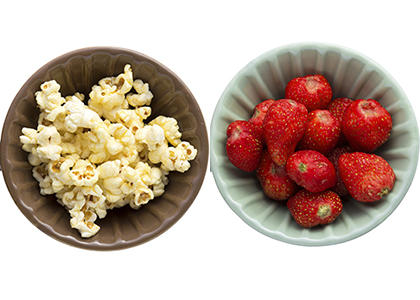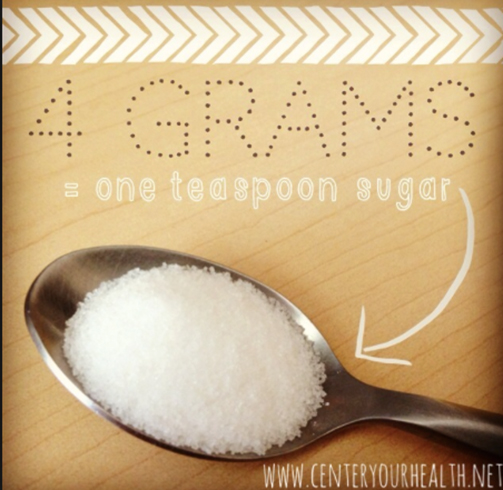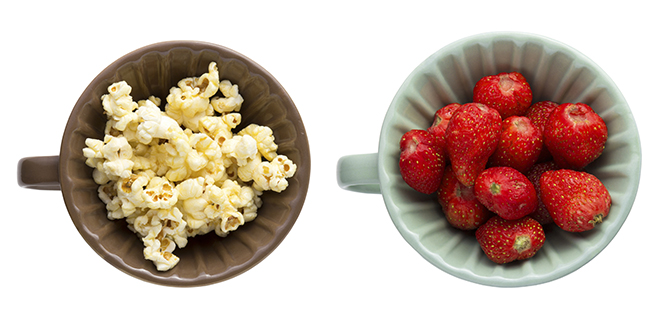
Cooking Tips: Everything to Know About Serving Sizes
By Kristen DeAngelis
Have you ever looked at a recipe and seen measurements indicating grams, teaspoons, and ounces and have no idea exactly how much that is? This poses a challenge to feel confident in nutrition recommendations like “limit added sugars to 6 tsp” or “aim for 2 liters of water a day”. How do these measurements actually relate in layman’s terms? There are many easy ways to make use of common items to understand serving sizes, units of measure and general health and nutrition recommendations, and I break it down for you here.
Units of Measurement
- Milligrams (mg) or Grams (g) are units of weight for non-liquid ingredients in cooking and grocery shopping. Keep in mind that 100g of a light weight food (like popcorn) will look much different in size than 100 g of a heavy food item (like tomatoes). Here are some comparisons to get a better understanding of what grams (g) and milligrams (mg) look like.
- 1 gram is roughly equal to 1 small paper clip or pen cap
- 100 grams of tomatoes is only 1 small-medium sized tomato
- 100 grams of popcorn is equal to 12 cups
- When comparing items in grams (g) or milligrams (mg), think about the weight and how much this will visually look like. Water rich foods like cucumber, and watermelon contain more water and more weight.
- Teaspoons (tsp) and Tablespoons (tbsp) measure the volume of food and is generally used for cooking, baking and blending. In the US and Canada, a tablespoon is generally the largest spoon used for eating, while a teaspoon would be compared to a very small dessert spoon. Note that Australia is the only country that classifies a tablespoon generally higher. Click here to use this easy converter if your still having trouble.
- 1 tablespoon = 3 teaspoons (US/UK/Canada) = 15 mL
- 1 tablespoon = 3 teaspoons or 20 mL (Australia) = 20 mL
- A tablespoon is measured by filling the spoon and scraping it level.
- Fluid Ounces (fl oz) Liters (L) and milliliters (ml) are units to measure liquid volume.
- 1 Fluid Ounce (fl oz) = 6 US teaspoons = 2 US tablespoons
- 8 Fluid ounces (fl oz) = 236 ml = 1 US Cup
- 16 Fluid Ounces = 500 mL = 2 US Cup
- 32 Fluid Ounces = 950mL = 4 US Cup
- The picture below demonstrates various measurements of household and commercial products: Poland Springs= 33.8 fl oz (1 L) Large Mason Jar= 32 fl oz (950 ml) and 16 oz (500 ml), Evolution Juice = 15.2 oz (450 ml), Medium Coffee Cup = 16 oz (500 ml)

Okay, so now the important question on how we should keep tabs on how much we are really consuming.
How to Keep Tabs On:
SUGAR
Added sugars should be avoided whenever possible and according to The American Heart Association should be limited to no more than 6 tsp for women, and 9 tsp for men. Monitoring sugar is important to maintain a heart healthy lifestyle and prevent a host of health problems including diabetes, pre-diabetes, and weight gain. So what does that look like?
- 1 teaspoon of sugar = 4 grams of sugar
- 1 gram of sugar = ¼ teaspoon of sugar
- Look for the amount of sugar (in grams) on a product’s ingredient label. Divide this by 4 to find the total teaspoons of sugar. (For example, a drink with 16 grams of sugar = 4 teaspoons of sugar.)

WATER
Water is vital to the human body with numerous health benefits. Individual needs vary based on many factors and the general recommendation to “Drink 8 glasses a day” is just a starting point.
The “8 cups or 2 liters” per day recommendation is perfect for some and may be too much or too little for others. Listen to your body and remember that herbal teas, coffee, and broth all count for fluid needs as well. But what does “8 glasses” of fluids look like to start with? Fill up 2 Liters of water (the size of a large Nalgene bottle or mason jar) and sip on throughout the day.
JUICE
When on a Reboot, it is important to aim for 4-6 juices a day. One serving of juice should be 16- 20 oz ( 500 ml), but what exactly does this look like? Fill up a 16 oz (500 ml) sized mason jar or note the size of most bottled HPP juices which are generally 15 – 16 oz (45-500 ml).

Food Groups Can Have Relative Portions to Household Items
What is 1 “serving” of fruits and vegetables?
- 1 cup of raw leafy vegetables (spinach, kale) = 1 baseball
- 1/2 cup of cooked vegetables (peppers, zucchini) = 1 computer mouse
- 1 cup of berries = 1 tennis ball
What is 1 “serving” of healthy fat?
- 1 teaspoon of olive oil = 1 die or your fingertip
- 1 tablespoon butter = a poker chip
What is 1 “serving” of plant based protein?
- 2 tablespoons of Hummus = 1 ping-pong ball
- 2 tablespoons of Almond Butter = 1 ping pong ball
- 1/4 cup of nuts = 1 golf ball or a small cupped hand
- 1/2 cup of cooked beans = light bulb
What is 1 “serving” of grains?
- 1 ounce of bread = 1 slice of bread = 1 CD Case
- 1 cup air popcorn = 1 baseball
- 1 cup cooked pasta = 1 baseball
For more Tips on monitoring amounts you can use your hand as a general guide. We love this imagery from PopSugar:


